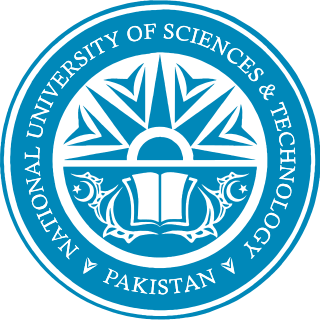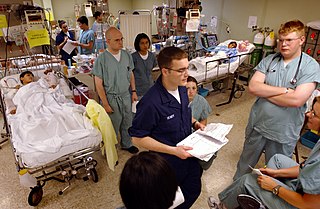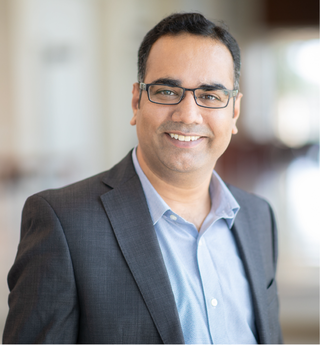Related Research Articles

Biomedical engineering (BME) or medical engineering is the application of engineering principles and design concepts to medicine and biology for healthcare applications. BME is also traditionally logical sciences to advance health care treatment, including diagnosis, monitoring, and therapy. Also included under the scope of a biomedical engineer is the management of current medical equipment in hospitals while adhering to relevant industry standards. This involves procurement, routine testing, preventive maintenance, and making equipment recommendations, a role also known as a Biomedical Equipment Technician (BMET) or as a clinical engineer.

Drexel University is a private research university with its main campus in Philadelphia, Pennsylvania. Drexel's undergraduate school was founded in 1891 by Anthony J. Drexel, a financier and philanthropist. Founded as Drexel Institute of Art, Science and Industry, it was renamed Drexel Institute of Technology in 1936, before assuming its current name in 1970.As of 2020, more than 24,000 students were enrolled in over 70 undergraduate programs and more than 100 master's, doctoral, and professional programs at the university.

The USC Viterbi School of Engineering is the engineering school of the University of Southern California. It was renamed following a $52 million donation by Andrew J. Viterbi, co-founder of Qualcomm.

The National University of Sciences & Technology (NUST) is a multi-campus public research university with its main campus in Islamabad, Pakistan.

The Budapest University of Technology and Economics, official abbreviation BME, is a public research university located in Budapest, Hungary. It is the most significant university of technology in the country and is considered the world's oldest institute of technology which has university rank and structure. It was founded in 1782.

The UTSA Klesse College of Engineering and Integrated Design (CEID) houses The University of Texas at San Antonio's Engineering and Architectural, Construction and Planning programs. It was originally founded as the College of Engineering but was renamed to the Klesse College of Engineering and Integrated Design (CEID) in 2021.

Clinical engineering is a specialty within biomedical engineering responsible for using medical technology to optimize healthcare delivery.
A Bachelor of Science in Biomedical Engineering is a kind of bachelor's degree typically conferred after a four-year undergraduate course of study in biomedical engineering (BME). The degree itself is largely equivalent to a Bachelor of Science and many institutions conferring degrees in the fields of biomedical engineering and bioengineering do not append the field to the degree itself. Courses of study in BME are also extremely diverse as the field itself is relatively new and developing. In general, an undergraduate course of study in BME is likened to a cross between engineering and biological science with varying degrees of proportionality between the two.

The Association of American Universities (AAU) is an organization of American research universities devoted to maintaining a strong system of academic research and education. Founded in 1900, it consists of 69 universities in the United States and two universities in Canada. AAU membership is by invitation only and requires an affirmative vote of three-quarters of current members.

The Florida International University College of Engineering and Computing, located in Miami, Florida in the United States is one of the university's 26 schools and colleges and was originally established in 1973 as the School of Technology. The College of Engineering and Computing offers bachelor's, master's and doctorate degrees within the college's 8 separate schools, departments and institutes. The college offers online and distance learning courses and programs through the Office of Distance Education. This office was previously known as FIU FEEDS, a statewide distance learning initiative adopted by the college in 1985.

The Purdue University College of Engineering is the engineering school and one of eight major academic divisions of Purdue University, a public research university in West Lafayette, Indiana. Established in 2004, its forerunner began in 1874 with programs in Civil and Mechanical Engineering.

Jashore University of Science and Technology, commonly known and abbreviated as JUST, is a government-financed public university in Bangladesh. JUST is located at Sadhinata Sarak in Jessore Sadar Upazila. Its postal code is Jessore-7408.
The College of Engineering at Michigan State University (MSU) is made up of 9 departments with 168 faculty members, over 6,000 undergraduate students, 10 undergraduate B.S. degree programs and a wide spectrum of graduate programs in both M.S. and Ph.D. levels. Each department offers at least one degree program, however many include more than one degree, multi-disciplinary programs, certifications and specialties as well as other degree programs affiliated with other colleges at Michigan State University.

The Henry Samueli School of Engineering (HSSoE) is the academic unit of the University of California, Irvine that oversees academic research and teaching in disciplines of the field of engineering. Established when the campus opened in 1965, the school consists of five departments, each of which is involved in academic research in its specific field, as well as several interdisciplinary fields. The school confers Bachelor of Science, Master of Science, and Doctor of Philosophy degrees.

The American Institute for Medical and Biological Engineering (AIMBE) is a non-profit organization founded in 1991, and headquartered in Washington. It represents 50,000 medical and biomedical engineers, and academic institutions, private industry, and professional engineering societies.
Martin (Maish) L. Yarmush is an academic, American scientist, physician, and engineer known for his work in biotechnology and bioengineering. His faculty career began in 1984 at MIT as a Principal Research Associate in the Department of Chemical Engineering. In 1988 he joined Rutgers University, as Professor of Chemical and Biochemical Engineering. In 1995, he returned to the Boston area to serve as the Helen Andrus Benedict Professor of Surgery and Bioengineering in the Harvard-MIT Division of Health Sciences and Technology, and to establish the Center for Engineering in Medicine at the Harvard Affiliated Teaching Hospitals. In 2007 he returned to Rutgers to hold the Paul and Mary Monroe Endowed Chair in Science and Engineering and serve as Distinguished Professor in the Department of Biomedical Engineering. He also holds a Lecturer in Surgery and Bioengineering position at Harvard Medical School, and is a member of the Senior Scientific Staff at the Shriners Hospital for Children, Boston.
The Penn State College of Engineering is the engineering school of the Pennsylvania State University, headquartered at the University Park campus in University Park, Pennsylvania. It was established in 1896, under the leadership of George W. Atherton. Today, with 13 academic departments and degree programs, over 11,000 enrolled undergraduate and graduate students, and research expenditures of $124 million for the 2016-2017 academic year, the Penn State College of Engineering is in the top 40 of engineering schools in the United States. It is estimated that at least one out of every fifty engineers in the United States got their bachelor's degree from Penn State. Dr. Justin Schwartz currently holds the position of Harold and Inge Marcus Dean of Engineering.

Ravi V. Bellamkonda is an Indian-American biomedical engineer and academic administrator. Since 2021, he has served as Provost and Executive Vice President for Academic Affairs at Emory University in Atlanta, Georgia. Bellamkonda was previously Vinik Dean of the Pratt School of Engineering at Duke University.

Akhilesh K. Gaharwar is an Indian academic and a professor in the Department of Biomedical Engineering at Texas A&M University. The goal of his lab is to understand the cell-nanomaterials interactions and to develop nanoengineered strategies for modulating stem cell behavior for repair and regeneration of damaged tissue.
Christine E. Schmidt is an American biomedical engineer. As a professor at the University of Florida, Schmidt was inducted into the Florida Inventors Hall of Fame for her creation of the Avance Nerve Graft which has "improved the lives of numerous patients suffering from peripheral nerve damage."
References
- ↑ "Biomedical Engineering Society".
- 1 2 "BMES". www.bmes.org. Retrieved 2021-05-07.